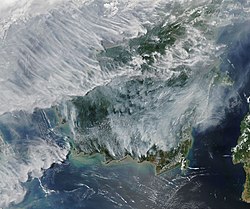
| Southeast Asian haze series |
|---|
 |
| History |
| Key topics |
| Responses |
| See also |
The 1997 group of forest fires in Indonesia that lasted well into 1998 were probably among the two or three, if not the largest, forest fires group in the last two centuries of recorded history.
Contents
In the middle of 1997 forest fires burning in Indonesia began to affect neighbouring countries, spreading thick clouds of smoke and haze to Malaysia and Singapore. Then Malaysian Prime Minister Mahathir Mohamad searched desperately for a solution, [1] and based on a plan by the head of the Malaysian fire and rescue department sent a team of Malaysian firefighters across to Indonesia under code name Operation Haze. This is to mitigate the effect of the Haze to Malaysia economy. The value of the Haze damage to Malaysian GDP is estimated to be 0.30 per cent. [2]
Seasonal rains in early December brought a brief respite but soon after the dry conditions and fires returned. By late 1997 and early 1998 Brunei, Thailand, Vietnam, the Philippines and Sri Lanka [3] had also felt the haze from the smoke of the forest fires. By the time the 1997–98 forest fires were finally over some 8 million hectares of land had burned while countless millions of people suffered from air pollution.